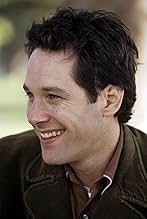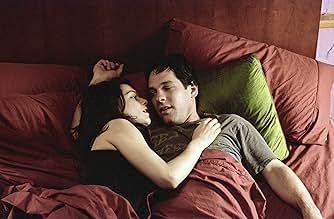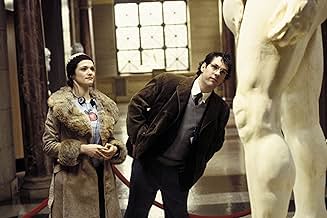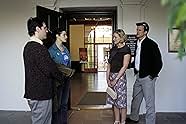AVALIAÇÃO DA IMDb
6,6/10
12 mil
SUA AVALIAÇÃO
Adicionar um enredo no seu idiomaA quiet, unassuming man begins to change in a major way as a result of meeting a new, art-student girlfriend, and his friends are unsettled by the transformation.A quiet, unassuming man begins to change in a major way as a result of meeting a new, art-student girlfriend, and his friends are unsettled by the transformation.A quiet, unassuming man begins to change in a major way as a result of meeting a new, art-student girlfriend, and his friends are unsettled by the transformation.
- Prêmios
- 1 indicação no total
Avaliações em destaque
Terrifying but so true tale about the way people can control us and the reasons we just let them do it. Rachel Weisz is amazing as art student who makes changes to a lonely guy who just wants to fit in. The story in true Neil Labute fashion takes a macabre turn and makes you question everything that you have done in your relationship and gives you a well deserved punch in the stomach in the reality department as well. The acting is beyond top of its game with Rachel Weisz proving once again to be one of the most talented and gifted actresses of our generation. Her performance is beyond brilliant and she single handily carries this movie on her shoulders with her performance. Paul Rudd, Fred Weller and Gretchen Mole do great work as well and Neil Labute proves once again to be a profound playwright of uncanny wisdom of the evil that resides in the human heart.
I do hope that Weisz and Labute work together again.
I do hope that Weisz and Labute work together again.
This film was absolutely not what I expected it to be. In the first half an hour, I even got a little bored, because it seemed like the story was going nowhere. Fortunately, I got my happy ending - no, not at all a film with a happy ending, just an ending that makes the film precious! It really makes you stare at the black screen, with the cast moving in front, and think about what you've seen over and over again. Of course, the brilliant play of Rachel Weisz cannot be left unmentioned, but I think that the others did a great job as well. "The Shape of things" is a film with actually just four actors and one great idea, and trust me, it is worth seeing. I am just wondering how would I feel the second time I watch it!
Years ago, when I was young and naive about movies, I read a harshly critical review of "The French Connection." The critic's main objection was that the movie deliberately rubbed the viewer's nerves raw in scene after scene, and then when that wasn't enough, applied something like cinematic rubbing alcohol to the abrasions to goad still more extreme reactions. The critic felt bruised and manipulated when the movie was over.
This movie doesn't rub nerves raw and then apply rubbing alcohol; it drills holes straight into the viewer's skull and pours in battery acid. The trouble with this approach is that the viewer is lobotomized almost instantly, unless the viewer is old enough and crusty enough to have seen the kinds of tricks that Hollywood uses to goad us into strong reactions. There's a scene where the anti-protagonist tells the people attending the unveiling of her latest art project that she knows some people will have strongly negative reactions to her work. "Diversity is good," she says in one of the only lines in the movie where her delivery registers just slightly above the robotic, "just don't be apathetic."
That's what the makers of this movie believe in. Love it or hate it, just please please pretty please don't yawn during the movie.
Well, I yawned.
This movie is the cinematic equivalent of every novel Ayn Rand ever wrote, in the sense that its "story" is really a manifesto, and it shows. Sure, if you're young and still intellectually a blank slate, but hungry for ideas, it can provide the starting point for vigorous debates. I suppose. For those of us who don't view the people around us as bugs in a collection, however (probably because we've already had our turns at being treated as a bug in a collection), this movie is just more pseudo-intellectual bile-venting all dressed up as serious, grown-up thinking. Consider such profound observations as, "Cute guys always develop a potty-mouth sooner or later; they think it makes them more adorable." Does this sound like Hegel to you? Or just a cheap cliché?
I wasn't outraged or shocked or horrified or invigorated or captivated or astonished or anything else by this movie, any more than I am by some modern art exhibit that consists of an empty room with flashing lights, or the feces of an artist in a tin, or a severed penis in a jar. No: Just bored. I've seen it before. Five or six years down the road, someone else will come up with essentially the same idea, but they'll have to twist the knife just a bit harder to try to get a reaction from an ever-more jaded audience.
Maybe this time the artist will kill her ersatz boyfriend. In the movie after that, she can cook and eat him. And in the one after that, she'll announce that the hors d'ouevres that her guests are nibbling are none other than the hapless Addam. Each will feature the same huge banner that reads, "Moralists have no place in an art gallery" (remember to make the letters EXTRA BIG like a Wal-Mart banner) and the same pale, Botoxesque, expressionless, emotionless "artiste" that the movie is lauding and skewering at the same time.
Yawn.
This movie doesn't rub nerves raw and then apply rubbing alcohol; it drills holes straight into the viewer's skull and pours in battery acid. The trouble with this approach is that the viewer is lobotomized almost instantly, unless the viewer is old enough and crusty enough to have seen the kinds of tricks that Hollywood uses to goad us into strong reactions. There's a scene where the anti-protagonist tells the people attending the unveiling of her latest art project that she knows some people will have strongly negative reactions to her work. "Diversity is good," she says in one of the only lines in the movie where her delivery registers just slightly above the robotic, "just don't be apathetic."
That's what the makers of this movie believe in. Love it or hate it, just please please pretty please don't yawn during the movie.
Well, I yawned.
This movie is the cinematic equivalent of every novel Ayn Rand ever wrote, in the sense that its "story" is really a manifesto, and it shows. Sure, if you're young and still intellectually a blank slate, but hungry for ideas, it can provide the starting point for vigorous debates. I suppose. For those of us who don't view the people around us as bugs in a collection, however (probably because we've already had our turns at being treated as a bug in a collection), this movie is just more pseudo-intellectual bile-venting all dressed up as serious, grown-up thinking. Consider such profound observations as, "Cute guys always develop a potty-mouth sooner or later; they think it makes them more adorable." Does this sound like Hegel to you? Or just a cheap cliché?
I wasn't outraged or shocked or horrified or invigorated or captivated or astonished or anything else by this movie, any more than I am by some modern art exhibit that consists of an empty room with flashing lights, or the feces of an artist in a tin, or a severed penis in a jar. No: Just bored. I've seen it before. Five or six years down the road, someone else will come up with essentially the same idea, but they'll have to twist the knife just a bit harder to try to get a reaction from an ever-more jaded audience.
Maybe this time the artist will kill her ersatz boyfriend. In the movie after that, she can cook and eat him. And in the one after that, she'll announce that the hors d'ouevres that her guests are nibbling are none other than the hapless Addam. Each will feature the same huge banner that reads, "Moralists have no place in an art gallery" (remember to make the letters EXTRA BIG like a Wal-Mart banner) and the same pale, Botoxesque, expressionless, emotionless "artiste" that the movie is lauding and skewering at the same time.
Yawn.
Neil Labute's shocker is nothing short of breathtaking with amazing performance by Rachel Weisz who is becoming the best actress we have around. The story is intense and the performance is great all around, and it will floor you once you finish seeing it. The biggest praise goes to Rachel Weisz, who single handily makes this movie as great as it is, and she carries this film on her shoulders all the way. Her performance is a tight rope of nerves and guts, and she does it all with style.
If you are looking for an intelligent movie with a great and fearless performance by one of the best actresses of our generation, this is it. If you can't take reality, then go hide under a rock.
If you are looking for an intelligent movie with a great and fearless performance by one of the best actresses of our generation, this is it. If you can't take reality, then go hide under a rock.
Rachel Weisz seems to be everywhere. From a Soviet partisan in besieged Stalingrad in "Enemy at the Gates" to a self-assured single mom in "About a Boy" and most recently as a grifter in "Confidence," she inhabits her roles with deft assurance.
Here, in Neil La Bute's play-brought-to-the-screen, "The Shape of Things," Weisz is a disturbing, thought-provoking challenging character: an artist in pursuit of a master's degree but in reality a tester of uncharted waters as she combines the creation of art with her relationship with a man who, like a canvas, is transformed from without. In this case by her.
Paul Rudd is Adam, an art gallery guard who Evelyn, the art student, first encounters in a quirky exchange that suggests an unfolding comedy. There are humorous moments but a darker side slowly emerges as Evelyn carefully encourages Adam to shed his dorky exterior. There's nothing new, of course, with the theme, "Change if you love me," but here Adam's relationship with his close friends, Phillip (Fred Weller) and Jenny (very well acted by Gretchen Moll) takes some disturbing turns. Is Evelyn a catalyst or an agitator? Is her commitment to art part of her persona or its sum total? These questions are increasingly explored in this short film. Does the name "Adam" have some esoteric meaning here?
Some plays don't travel well to the screen. This one does. La Bute's play seems to have been little altered by him for a screenplay.
What is the place of ideas and intellectual experimentation in the creation and fostering of an intimate relationship? Are there boundaries that must be respected even if truth is sacrificed in the process? Does art illuminate or camouflage the reality of a relationship? No ready answers and no final ones here but the effort yields a thought-provoking study.
Rachel Weisz's emerging and brooding intensity is the anchor for this unusual film. She also produced the movie.
The score is by Elvis Costello. His fans will appreciate the soundtrack.
8/10.
Here, in Neil La Bute's play-brought-to-the-screen, "The Shape of Things," Weisz is a disturbing, thought-provoking challenging character: an artist in pursuit of a master's degree but in reality a tester of uncharted waters as she combines the creation of art with her relationship with a man who, like a canvas, is transformed from without. In this case by her.
Paul Rudd is Adam, an art gallery guard who Evelyn, the art student, first encounters in a quirky exchange that suggests an unfolding comedy. There are humorous moments but a darker side slowly emerges as Evelyn carefully encourages Adam to shed his dorky exterior. There's nothing new, of course, with the theme, "Change if you love me," but here Adam's relationship with his close friends, Phillip (Fred Weller) and Jenny (very well acted by Gretchen Moll) takes some disturbing turns. Is Evelyn a catalyst or an agitator? Is her commitment to art part of her persona or its sum total? These questions are increasingly explored in this short film. Does the name "Adam" have some esoteric meaning here?
Some plays don't travel well to the screen. This one does. La Bute's play seems to have been little altered by him for a screenplay.
What is the place of ideas and intellectual experimentation in the creation and fostering of an intimate relationship? Are there boundaries that must be respected even if truth is sacrificed in the process? Does art illuminate or camouflage the reality of a relationship? No ready answers and no final ones here but the effort yields a thought-provoking study.
Rachel Weisz's emerging and brooding intensity is the anchor for this unusual film. She also produced the movie.
The score is by Elvis Costello. His fans will appreciate the soundtrack.
8/10.
Você sabia?
- CuriosidadesWas originally a play starring Paul Rudd and Rachel Weisz, which played in London in the summer of 2001.
- Erros de gravaçãoIn the park scene where Adam and Jenny kiss, Adam's nose looks normal, but at this point he hasn't had the surgery yet. The surgery happens in the next scene.
- Trilhas sonorasLover's Walk
Written by Elvis Costello
Performed by Elvis Costello and The Attractions
Courtesy of Demon Music Group, Ltd., by Elvis Costello
By Arrangement with Rhino Entertainment Co. and Warner Special Products
Principais escolhas
Faça login para avaliar e ver a lista de recomendações personalizadas
- How long is The Shape of Things?Fornecido pela Alexa
Detalhes
- Data de lançamento
- Países de origem
- Idioma
- Também conhecido como
- The Shape of Things
- Locações de filme
- Empresas de produção
- Consulte mais créditos da empresa na IMDbPro
Bilheteria
- Orçamento
- US$ 4.000.000 (estimativa)
- Faturamento bruto nos EUA e Canadá
- US$ 735.992
- Fim de semana de estreia nos EUA e Canadá
- US$ 173.246
- 11 de mai. de 2003
- Faturamento bruto mundial
- US$ 826.617
- Tempo de duração
- 1 h 36 min(96 min)
- Cor
- Mixagem de som
- Proporção
- 2.35 : 1
Contribua para esta página
Sugerir uma alteração ou adicionar conteúdo ausente




























